Uni High Students Experience
Cutting-Edge Research at Illinois
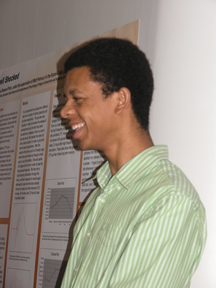
Tahar Bowen-Pinto presenting a poster of his Illinois summer research experience on high-frequency stimulation.
July 11, 2012
On the northeastern edge of campus, University Laboratory High school’s proximity to Illinois’ myriad research facilities made it an ideal partner for I-STEM’s pilot project offering summer research opportunities to high school students. Of the 50 or so students who applied, 19 were chosen on the basis of both their performance in science and math and of their application, which included an essay on their interest in science and how participating would prepare them for a possible career in science.
The brainchild of Lizanne DeStefano, Director of I-STEM, the experience was designed to increase the number of students that choose STEM careers: "One of the things that we hear about so much today is the low numbers of U.S. students who are interested in science, technology, engineering, and mathematics, particularly among females and students of color. Very low percentages of them choose STEM as careers. One of the things that I-STEM is charged with doing is to look at how we can increase the diversity and the magnitude of people going into STEM fields." She says research indicates: "The earlier that students are engaged in STEM, the better. Many kids don’t get exposed to those things until they get into high school or college, and by that time they’ve already decided what things they like and what things they don’t like."
The goal of the project was to provide high school students an authentic research experience, which DeStefano succinctly defines as: "the good, the bad, and the ugly!" She continues, "We wanted to have an experience that really taught students what it was like to do science: the interesting, fun things; the boring things; the compliance things; and then let them decide whether or not this was a field they wanted to go into."
And the program did just that, according to David Stone, a Uni biology teacher who was heavily involved in both planning and administrating the program: "The clear benefit is the chance for the kids to go in and work in a lab; there's the hands-on experience, which I think is very important; but I think that just as important is getting a sense of the culture of a lab...how it works. It gave them a sense of whether they saw that as being something that would work for them in their future...the opportunity to see one little slice of life in a lab, and experience the culture. All of them did that." And according to Stone, they did indeed experience not only the "good," but the "bad and the ugly": "Some of them were able to get great data that significantly advanced something—others did not."
Besides its proximity to campus, Uni was chosen to pilot the program because of the interest of its teachers and principal, Dr.Jeffrey Walkington, in providing its students a research experience. According to Walkington, "Uni is trying to work really hard to burst out of its four walls; we're trying to forge a lot of relationships with the University. Beyond concurrent enrollment, which a lot of our students do, taking courses at the University, we’ve hoped to do more formal, structured internships like this. We’ve always had students who have found their own internships—a parent that they know who’s involved in some kind of research, that kind of thing—but the I-STEM program is doing this in a lot more systematic way." Walkington calls the program, "terrific," and offers additional praise: "It’s one of the things I’m most proud of since I got here."
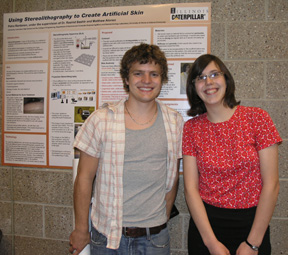
Petra Rantanen poses with her grad student mentor, Matthew Alonso, at the project's culminating poster session.
Besides the application process described above, the program, which was carefully crafted by DeStefano, Walkington, and Uni teachers, involved mentorship by not only university researchers, but by Uni teachers, like Stone. Students were to record their experiences in lab notebooks, which they turned in to their mentors as part of the requirement for Uni course credit. In addition, weekly meetings were held at Uni to monitor the experience. Stone credited these meetings as being one of the strengths of the program: "Weekly meetings allowed all the the kids to gain some perspective." He further elaborated that the Friday meetings gave kids "the chance to touch base; the chance for the kids to see the diversity of things that were occurring; the chance for the kids to see that not everybody gets great data all the time, and sometimes there are tedious aspects to things, and that's ok." Finally, there was a poster presentation at the end, which was well attended by not only students' relatives, but the professors, grad students, and post docs who had worked closely with the students.
At the core of the experience—the opportunity of a lifetime—students got to work in the university's state-of-the-art labs under some of the premier researchers in their fields. University faculty who served as mentors to these students included a veritable who’s who of cutting-edge researchers, including Rashid Bashir, Monica Fabiani, Lawrence Schook, and Placid Ferreira, to name a few. Students were assigned to professors whose research dovetailed with students’ expressed interests in various fields and were often allowed to choose which of the researchers’ projects they would like to work on.
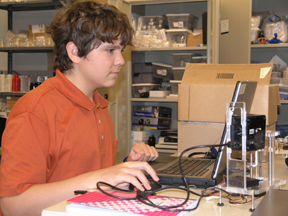
Evan Ramos works to develop a program to automate the 3-D printing technolgy in the Nano-CEMMs lab .
For example, several students, mentored by Placid Ferreira, were involved with NanoCEMMS’ 3D printing technology which uses projectors and a photo-sensitive polymer which solidifies when exposed to ultraviolet light. A PowerPoint presentation with white shapes on a black background is projected on the polymer using a projector which shines ultraviolet light onto the polymer, causing it to solidify in layers, and, thus, slice by slice, the shape is created. Evan Ramos, who intends to go into computer science as a profession, worked to automate the process so the user doesn’t have to manually adjust the slides and advance the PowerPoint frames. Using a servo motor and self-contained projector with an LED, both connected to a computer, Evan wrote a program to time the motor so it automatically makes the object, not only faster, but without human error. To simplify the design process (rather than creating each layer in PowerPoint), Evan is also writing a program which will output a series of projector images from an STL file, the 3D model format normally used in fabrication.
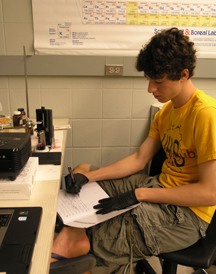
Conrad Schloer recording data during his research on the 3-D printing technology dye.
The 3D printing technology uses dye which absorbs the UV light, only allowing the light to go to a certain depth, and thus controls the thickness of the polymer. The light is exposed to the polymer from 4 to 10 seconds; the longer it is exposed, the thicker the object created. However, because the dye is slightly carcinogenic, Conrad Shloer worked to determine how researchers could obtain quality results with limited human exposure to the dye. So he experimented with both the amount of dye used and with using the same amount of dye, but varying the length of time. From the data he obtained from his various tests, he plotted a graph, from which he derived an equation to predict the thickness based on the length of time. Ostensibly, based on the time of exposure, he should be able to predict the thickness of the layer. However, at longer lengths of exposure, such as 16 seconds, the polymer melted. Thus, he discovered there is an upper limit to the length of exposure, with the optimum length of time being around 10 seconds.

Kathy Qiu in the Nano-CEMMs lab at Illinois.
Kathy Qiu also worked with the dye, testing it to see if it is toxic enough to kill E. coli cells. (She did qualify that the E. coli she has been working with is “really safe; you could actually drink it, and nothing would happen to you.” She acknowledged that she hasn’t done so, of course.) Her experiment involved spacing tiny discs of filter paper out on auger plates, then growing liquid cultures of e coli, creating different dilutions of the dye, then dropping them onto the auger plates. A zone of inhibition, i.e., a ring around the disc where the solution was clear and not cloudy, meant the dye had killed the e coli bacteria. Her preliminary conclusion: the dye does not kill E. coli. When asked what she has learned working with Professor Jerrod Henderson this summer,, Kathy indicated: “When you do laboratory work, there are a lot of hands-on activities involved; it’s not just thinking. For a lot of the experiments, you have to be good with hands-on coordination.” Although she will probably go into engineering, not chemistry, her summary of the experience was: “It’s actually pretty fun, I think.”
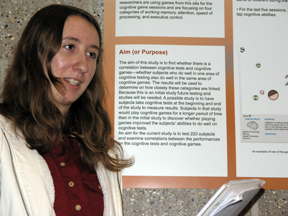
Halley Pollock Muskin presenting the results of her research on cognitive tests and games.
Halley Pollock Muskin’s interest in science undoubtedly stems from the fact that her father was her teacher in some of her middle science classes. Because he was affiliated with the University, she reminisces, “He got to do really cool things. He had sand that was coated in nano particles, so it didn’t get wet!” Her I-STEM project, under the direction of Art Kramer, was trying to find out how cognitive tests and cognitive games are linked. Students were tested on a computer and on written tests, doing memory tests to recite back lists; after that the subjects played games, which tested the same things. The object was to see if the test scores could predict the game scores. She was also working with a project that tests how well 7-to-10-year-olds cross the street under three different conditions (with no distractions, talking on a cell phone, and listening to music.) When asked if this experience has changed her perception of what research is, Halley indicated that it had. She reported: “I used to think that research was mainly done in a lab by yourself; but the research I’m doing now is working with people and testing people, so it’s very different from what I thought.”

Marina Shah exhibiting the helmet researchers at Beckman Institute use in their study on how the brain changes with age.
Also dealing with age, the project Marina Shah has been part of looks at the way the brain changes with age. This project, under the direction of Monica Fabiani, used a machine with lasers and detectors which sense where activity is in the brain. Wearing a nifty helmet (see image to the left), subjects (currently retired persons) were to press a button to indicate whether words were above or below a fixed point. Although she intends to go into pre-med in college, since participating in the project, Marina has become more interested in psychology and says research seems more interesting now than it did before. However, Marina’s interest in science began in fourth grade: “I had a really good science teacher; I think that’s when I got interested in science.”

Petra Rantanen at work on her summer research project in her lab at Illinois.
Petra Rantanen originally didn’t like science at all. But after taking biology, she thought, “That was pretty cool!” After taking chemistry, she said to herself, “Oh, this is actually kind of fun! Maybe I should learn more.” And her research experience this summer in Illinois' Micro Nano Technology Lab has helped her learn a lot more. Her project was developing a machine to create a fake heart. The original machine used lasers to create a fake heart from polymer. Eventually, it will be a robot that uses heart sounds to move. Because she indicated on her application that she wants to be a doctor, she was originally assigned to Vet Med to work with pigs. Allergic to pigs, Petra was reassigned to work with Rashid Bashir. Petra, who came away from the project with a clearer understanding of what engineering is, thinks it’s a field she might want to go into: “I think it’s fun…I didn’t really know what engineering was; I think it’s kind of cool, because it’s sort of like design. I never really knew that before, I guess.”
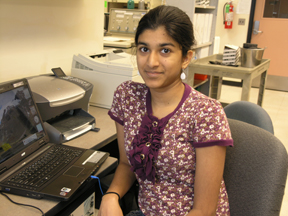
Aishwarya Gautam searching an online database of MRNA sequences.
Aishwarya Gautam, who will be a senior this upcoming school year, worked in Larry Schook's lab this summer. Her research project on genetics involved looking for MRNA sequences in an online database, keeping track of what species they’re for, as well as what the tissue location is for two different enzymes, BHMT1 and BHMT2. Scientists are trying to find out why placental mammals have both, while other mammals only have BHMT1, which could be evolutionarily significant. Aishwarya was assigned this project based on her expressed interest in genetics and expects to be in a career involving some kind of science, possibly genetics.
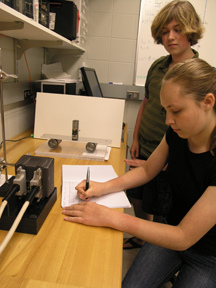
Brianna Hajek and Leif Hague work to synchronize metronomes in their summer research project on cardiac cells.
Brianna Hajek and Leif Hague were involved in Taher Saif's project studying cardiac cells, which beat synchronously. For example, when cells taken from a rat’s heart are placed in a container, they beat separately. But at the point that connective tissue joins these cells together, they begin to beat in synchronization again. The great debate is whether this is mechanical or electrochemical. The study is modeling this using metronomes, which are purely mechanical. For example, if metronomes are placed on a flat plate resting on two soda cans, as it rocks, the metronomes synchronize. They traced the pendulums’ movement to obtain its sine wave, which they will compare to the sine wave of a beating heart. If the waves are very similar, they will know it is mechanical. Part of Brianna and Leif’s assignment was to test a variety of variables to determine how to best do the experiment and the synchronizing in order to obtain the sine wave. First they took high-speed videos of metronomes’ pendulum movement, then via frames extracted from the videos, used a special program to track pendulum movement. Since metronomes are inaccurate, they had to first find the frequencies of the metronomes. Other variables included the resolution of the videos and the number of pixels the program tracked.

Chelsea Edwards and a guest examine her poster at the the culminating event of the I-STEM Summer Research Experience.
Soon-to-be-junior Chelsea Edwards’ project designing a chip to count malarial parasites and CD4+ T-cells, a novel and inexpensive way to diagnose AIDS and malaria. The HIV virus targets CD4, a surface receptor on some white blood cells; as a person with AIDS loses CD4+ white blood cells, his or her body loses its ability to defend itself from other diseases. Chelsea has been interested nano-technology for quite a while, and is pretty sure she’s headed for a career in science. “I think I already decided that I wanted to go into science, but this helped me understand more what scientists actually do, and what their day is like, and how they can actually help people.” After learning about the technology of Lab-on-a-Chip’s current project—the CD4 cell-counting design, she designed a chip that screens for both AIDS and malaria at the same time. There’s currently no way to count all four malaria species separately, but this chip will enable health-care workers to do so quickly and affordably. The ambitious goal of Rashid Bashir's Lab-on-a-Chip project is to create the technology to do cell counts for all blood maladies.
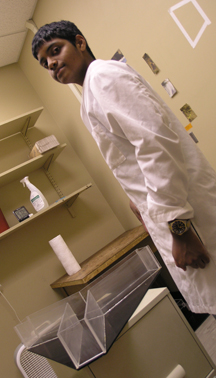
Sunjay Koshy with one of the T-shaped mazes used for the exercise and memory trials.
Sunjay Koshy studied exercise and memory. Researchers in Donna Korol's psychology lab worked with two groups of rats: an experimental group, which had access to a running wheel, and a control group, which did not. Rats in the experimental group could run at will, with researchers recording their activity. At the end of three weeks, each rat was placed in a T-shaped maze (see image to the right) with food at one arm of the maze, to test its ability to learn. In place learning, the rat learned to use spacial clues to find the food; in response learning, for example, it learned to always turn left to find the food. At the end of the tests, researchers examined images of stained slices of the rats’ brains. The darker staining signaled more succinate dehydrogenase activity (which helps in the production of ATP, a unit of energy for metabolic activity, and thus a more active brain. Sedentary rats didn’t have as much staining (and therefore brain activity) as the rats that had access to exercise: a lesson for us all. Regarding this opportunity to help out at a working research lab, Sunjay acknowledges: "It was a really cool experience." Has the opportunity to do research this summer impacted has choice of a career? "At first I wasn't sure, but after doing this I-STEM program, I'm pretty sure I want to go into something like this." Has this experience changed his perception of what a researcher does? "Yea. I didn't know how much effort you have to put into it; and a lot of stuff you have to know to do it; it's really interesting."
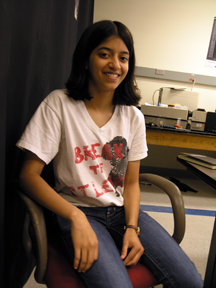
Shruti Vaidya takes a break from research in her lab at the Chemistry Life and Sciences building.
Shruti Vaidya worked with Catherine Murphy's chemistry project studying the interaction of cells with gold nanoparticles, which could be useful in a treatment for cancer. Because nanoparticles can sediment, i.e., the concentration of nanoparticles on the cell surface may be higher than the initial concentration, this could lead to increased uptake by cells. Shruti’s study varied the shape (spheres and rods) and coating (PAA or PAH) of nanoparticles and the types of human cells: human dermal fibroblast (HDF) and pancreatic cancer cells (PC3). Cells were placed on a glass slide, gold nanoparticles were added, and cells were imaged with a microscope every five minutes for 24 hours. Their study found that cells do interact with sedimented nanoparticles on the surface: cancer cells were observed moving about, “vacuuming” up nanoparticles, leaving behind a trail void of nanoparticles, which accumulated in/on cells over time. Shruti, who has always been interested in science, reports that her summer research experience has "definitely gotten me interested in research—maybe not chemistry."
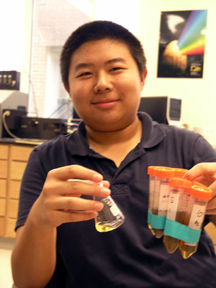
Yulun Wu displaying test tubes he generated in his work to synthesize and stabilize silver nanoparticles.
Yulun Wu’s research, also under the mentorsip of Catherine Murphy, involved the synthesis and stabilization of silver nanoparticles, specifically, how to prevent silver from plating itself on the container or whatever is in the solution. Yulun experienced the vagaries of research, as the use of some bad borohydride resulted in a number of lost days and failed tests. Despite some disappointments, Yulun discovered that the decay rate of the solution exposed to light and air resulted in a fast decay rate; to light but not air, a slower rate; and to air but not light, a slow rate. While too much or a lack of the capping agent, citrate, resulted in precipitation, varying the amount of citrate seemed to stabilize the silver nanoparticles.Of this discovery, Yulun reported, “But what I did realize was that if you vary the amount of citrate, the color is actually different...when you have a certain amount of citrate to cap the nanoparticle, it stabilizes it,so that I did figure out. I was pretty happy about that." Regarding potential future research in this area, Yulun reports: "As we move closer to an unknown middle value, precipitation grinds to a halt. There must be a value, a ratio that would result in the absolute minimum decay rate.” Yulun has always been interested in chemistry, but reports, “I can’t say I always liked it; there were some days when I was really mad, like when I figured out my borohydride was bad!”

Nick Cho presenting the results of his research at the culminating poster session.
As a youngster, Nick Cho was interested in science: “Since I was a kid, I always dreamed of working in a lab. I definitely am proud of working in I-STEM this summer, and I definitely did have a great experience working in the lab.” Nick’s project in Larry Schook's lab involved peptides, which block neutrophils, the culprits responsible for post-heart-attack scarring of heart tissue. This scarring is the after-effect of a heart attack. When the blood flow returns back into the heart, neutrophils, which travel through the body via blood vessels, interact with the ICAM-1 and VCAM-1 that line the heart, replacing good tissue with scar tissue. Nick’s role was to insert VCAM proteins into a dsRED vector, then put this combined vector, which shows up the color red under a microscope, into a blank cell. Nick didn’t get the results he wanted: a successful ligation, where the VCAM is put into the vector; nor was he able to grow products from a bacterial cell culture. “It was pretty frustrating, but at the same time, I just accepted it as part of what research actually is.” Despite his disappointing results, he still is considering a career in research in biochemistry or bioengineering. “It’s definitely something I want to do. By doing this lab work, I revitalized my love for biology. I haven’t taken biology in a couple of years, but by doing this, I remembered how much I love biology.” And in college, he would like to find a project like this one—and continue where he left off.
Author/Photographer: Elizabeth Innes, Communications Specialist, I-STEM Education Initiative
More: 8-12 Outreach, High School Research, I-STEM Initiatives, Summer Research, Underserved Minorities, Uni High, 2012













.jpg)
















